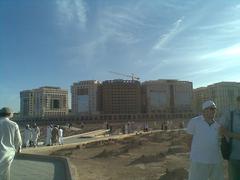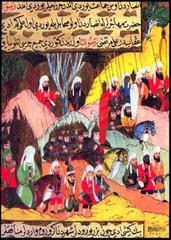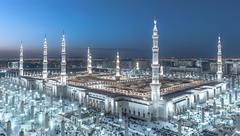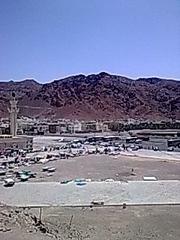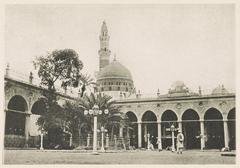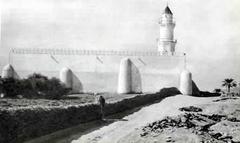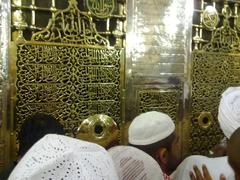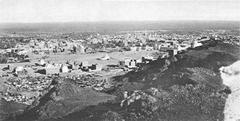Mosque of Al-Ghamama: Visiting Hours, History, and Guide to Medina’s Historic Sites
Date: 04/07/2025
Introduction
The Mosque of Al-Ghamama, a cherished landmark in the heart of Medina, Saudi Arabia, is a site of immense historical, religious, and architectural importance. Located approximately 300 to 500 meters west of Al-Masjid an-Nabawi (the Prophet’s Mosque), this mosque is intimately connected to key moments in early Islamic history. It is famously associated with the Prophet Muhammad’s (peace be upon him) prayer for rain during a severe drought—a miracle that gives the mosque its name, “Al-Ghamama” (“the cloud”). This event, along with its use for the Prophet’s Eid prayers, marks the mosque as a symbol of divine mercy, faith, and communal unity.
With centuries of history reflected in its evolving architecture—from the Umayyad and Ottoman periods to modern Saudi restorations—Al-Ghamama Mosque stands as a living testament to Medina’s layered cultural and religious heritage. This guide provides comprehensive information for visitors, including visiting hours, accessibility, etiquette, and highlights of nearby historical attractions. Whether you are a spiritual pilgrim or a history enthusiast, use this guide to enrich your visit to one of Medina’s most treasured landmarks.
For authoritative updates and details, refer to resources such as the Madain Project, the General Presidency for the Affairs of the Two Holy Mosques, and IslamicFinder.
Table of Contents
- Historical Background
- Religious and Cultural Significance
- Architectural Features
- Location and Accessibility
- Visitor Information: Visiting Hours, Tickets & Guidelines
- Etiquette and Guidelines for Visitors
- Practical Tips for a Memorable Visit
- Preservation and Community Role
- Nearby Attractions in Medina
- Frequently Asked Questions (FAQ)
- Summary and Final Tips
- Sources and References
- Internal Links
Historical Background
The Mosque of Al-Ghamama (Arabic: مسجد الغمامة) is among Medina’s oldest and most revered sites, established during the early Islamic period. Its name, “Ghamama,” meaning “cloud,” links directly to the Prophet Muhammad’s (PBUH) famous prayer for rain (Salat al-Istisqa). During a period of severe drought, the Prophet prayed at this location, after which clouds gathered and rain fell, marking a moment of divine intervention that is commemorated to this day (Madain Project).
Historical records indicate that the mosque was also the site where the Prophet performed Eid prayers during the last years of his life and held the funeral prayer in absentia for Najashi, the Christian king of Abyssinia who embraced Islam. These events cemented the mosque’s status as a focal point for the early Muslim community.
The original structure is believed to have been commissioned by Caliph Umar bin Abdul Aziz (r. 717–720 CE). The mosque has since undergone significant renovations, including work by Sultan Hasan bin Muhammad bin Qalawan al-Shalihi in 1340 CE, expansions during the Sharifate and Ottoman eras, and restoration under King Fahad bin Abdul Azeez al-Saud in the modern period (Madain Project).
Religious and Cultural Significance
Association with the Prophet Muhammad (PBUH)
Al-Ghamama Mosque’s primary significance lies in its association with the Prophet Muhammad (PBUH), particularly the miracle of the rain prayer and its use for communal Eid prayers. These traditions underscore the mosque’s enduring spiritual resonance and its role as a symbol of faith, unity, and divine mercy (General Presidency for the Affairs of the Two Holy Mosques).
Communal and Spiritual Center
The mosque’s proximity to Al-Masjid an-Nabawi made it a natural gathering place for large congregations, especially during Eid when space at the main mosque was limited. This tradition continues today, with the mosque serving as a spiritual and cultural hub for Medina’s residents and visitors.
Architectural and Cultural Heritage
The mosque’s layered history is evident in its architecture, which reflects influences from the Sharifate and Ottoman periods while preserving traditional Islamic design elements. Its continued preservation highlights the deep reverence for sites connected to the life of the Prophet Muhammad and Medina’s broader heritage (IslamicFinder).
Architectural Features
The Mosque of Al-Ghamama exemplifies Islamic architectural elegance with Ottoman influences.
- Layout: Rectangular structure with an entrance area and a prayer hall.
- Domes: Six domes in total—five above the facade and a large central dome above the mihrab (prayer niche), creating a distinctive silhouette.
- Mihrab and Minbar: Features a finely carved stone mihrab and a wooden minbar with geometric motifs, reflecting restrained Ottoman decorative elements.
- Exterior: Built with locally sourced stone and finished with smooth plaster. The mosque’s facade includes arched windows and minimal stonework.
- Minaret: Unlike many Ottoman mosques, Al-Ghamama lacks a prominent minaret, preserving its early authenticity.
- Interior: The prayer hall is supported by stone columns and decorated with traditional carpets. Colored glass windows and high domed ceilings provide natural light and ventilation.
- Accessibility and Restoration: Recent restorations have improved accessibility, added modern amenities, and preserved historical features (Islamic Architectural Heritage).

Alt text: Exterior view of the Mosque of Al-Ghamama in Medina, showcasing its Ottoman-era domes and minaret.
Location and Accessibility
The mosque is centrally located in Medina, approximately 300 meters from the courtyard gate of Al-Masjid an-Nabawi and about 500 meters west of the Prophet’s Mosque’s As-Salam door (Madain Project). Its central position makes it easily accessible for both pilgrims and tourists, with well-maintained walkways, clear signage, and proximity to other significant Islamic sites.
Recent upgrades ensure that ramps, smooth pathways, and signage in both Arabic and English are available. The mosque is also reachable via public transport and is a 10-minute walk from Al-Masjid an-Nabawi.
Visitor Information: Visiting Hours, Tickets & Guidelines
- Visiting Hours: The mosque is open daily from approximately 5:00 AM to 10:00 PM, in alignment with the five daily prayers. Hours may vary during Ramadan and major Islamic events.
- Entry Fee: There is no entrance fee; visiting the mosque is free for all.
- Best Times to Visit: Early mornings and late afternoons are ideal for a quiet, contemplative visit.
- Guided Tours: Available through local tour operators and the official Saudi tourism portal. Check with hotels or visitor centers for up-to-date information.
- Special Events: The mosque hosts special congregational prayers during Eid and other Islamic occasions, drawing large gatherings.
Etiquette and Guidelines for Visitors
- Dress Code: Modest attire is required. Men and women should cover arms and legs; women should wear a headscarf (Saudi Tourism Authority).
- Shoes: Remove shoes before entering the prayer hall.
- Behavior: Maintain silence, mute mobile devices, and avoid loud conversations.
- Photography: Permitted outside and in the courtyard, but discouraged during prayers or of worshippers without permission.
- Respect Prayer Times: Avoid disruptions or photography during prayer sessions.
- Non-Muslim Visitors: May be permitted to visit outside of prayer times, but should confirm local guidelines beforehand.
Practical Tips for a Memorable Visit
- Combine your visit with nearby sites such as Al-Masjid an-Nabawi and Abi Bakr Mosque.
- Stay hydrated and use sun protection, especially during hot months.
- Hire a local guide for greater historical insight.
- For visitors with limited mobility, verify accessibility needs in advance.
- Use virtual tour options or interactive maps from official tourism websites to plan your route.
Preservation and Community Role
The Mosque of Al-Ghamama remains an active place of worship and a vital part of Medina’s spiritual landscape. Successive rulers have prioritized its preservation, ensuring the mosque retains its historical character while meeting the needs of contemporary worshippers. Community prayers and educational programs hosted at the mosque foster ongoing engagement with Medina’s Islamic legacy (Saudi Press Agency).
Nearby Attractions in Medina
- Al-Masjid an-Nabawi: The Prophet’s Mosque, one of the holiest sites in Islam.
- Quba Mosque: The first mosque built in Islam, about 5 km from Al-Ghamama.
- Uhud Mountain: Historic site of the Battle of Uhud, approximately 4 km north.
- Abi Bakr Mosque: Another early Islamic mosque nearby.
- Medina Museum: Offers insights into Islamic history and the city’s evolution.
Exploring these sites provides a comprehensive understanding of Medina’s rich Islamic heritage.
Frequently Asked Questions (FAQ)
Q: What are the Mosque of Al-Ghamama visiting hours?
A: The mosque is generally open from 5:00 AM to 10:00 PM, in line with prayer times. Confirm hours locally, especially during Ramadan.
Q: Is there an entrance fee or ticket required?
A: Entry is free; no tickets are required.
Q: Are non-Muslims allowed to visit?
A: Non-Muslim visitors may be allowed outside of prayer times; check local regulations.
Q: What is the best time to visit?
A: Early mornings or late afternoons offer a peaceful experience.
Q: Are guided tours available?
A: Yes, through local operators and official tourism channels.
Q: Is the mosque wheelchair accessible?
A: Yes, recent improvements have enhanced accessibility.
Q: Is photography allowed?
A: Photography is allowed with permission, provided it does not disturb worshippers or occur during prayers.
Q: How do I get there from Al-Masjid an-Nabawi?
A: The mosque is about a 5-minute walk (300 meters) from the courtyard gate of Al-Masjid an-Nabawi.
Summary and Final Tips
Visiting the Mosque of Al-Ghamama offers a profound opportunity to connect with Islamic history, spirituality, and architectural heritage. Its proximity to Al-Masjid an-Nabawi and other significant landmarks makes it an essential stop for pilgrims and tourists. The mosque’s historical association with the Prophet Muhammad’s prayers—especially the Salat al-Istisqa’ (rain prayer) and Eid congregations—imbues it with lasting religious significance.
Modern restorations and accessibility enhancements ensure comfort and authenticity for all visitors. To maximize your experience, plan your visit with the provided guidelines, respect mosque etiquette, and explore nearby historical sites. For continuous updates, prayer timings, and travel tips, download the Audiala app and follow related social media channels.
Embrace the unique chance to explore Medina’s historic Mosque of Al-Ghamama and immerse yourself in the spiritual and cultural legacy it represents.
Sources and References
- Mosque of Al-Ghamama: Visiting Hours, History, and Medina’s Historical Sites, 2025, Madain Project (https://madainproject.com/ghamama_mosque)
- Al-Ghamama Mosque Visiting Hours, Tickets, and Historical Significance in Medina, 2025, General Presidency for the Affairs of the Two Holy Mosques (https://www.gph.gov.sa/)
- Al-Ghamama Mosque Visiting Hours, Tickets, and Historical Significance in Medina, 2025, IslamicFinder (https://www.islamicfinder.org/)
- Masjid Al-Ghamama: Visiting Hours, History, and Architectural Highlights in Madinah, 2025, Islamic Architectural Heritage (https://www.islamicarchitecturalheritage.com/listings/masjid-al-ghamamah)
- Mosque of Al-Ghamama Visiting Hours, History & Tips for Medina’s Historic Site, 2025, Madain Project (https://madainproject.com/ghamama_mosque)
